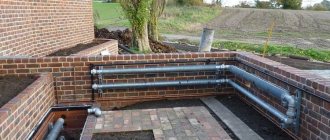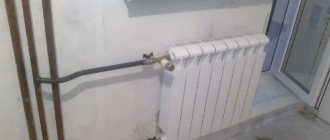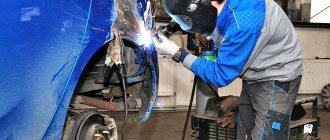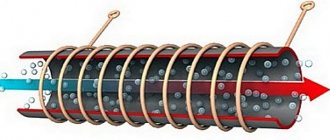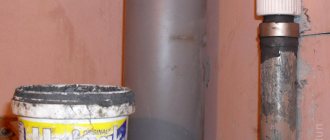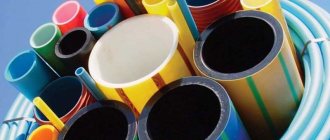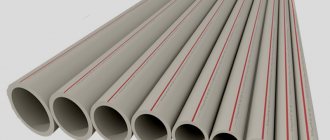Welding metals and materials is not limited to the arc welding method alone. Today there are a large number of types and methods of welding and it is possible to select the appropriate joining method for almost any application.
Russian industrial standards classify welding methods according to three criteria: technical, physical and technological. Physical determines the form and type of energy used to connect materials. Classes are determined by the form of energy, and types of welding are determined by GOST by the type of energy. According to this division, there are three large classes:
- thermal - using melting materials using thermal energy,
- thermomechanical – using thermal energy and pressure,
- mechanical - using mechanical energy to connect parts.
Each includes a large number of different welding types suitable for different application conditions.
The classification of welding types refers to technological specific features of a particular method, for example, the characteristics of the welding current, the type of electrode and other parameters. Technologically, welding is distinguished using filler wire, metal or non-consumable electrode, alternating or direct current, etc.
Technical characteristics determine the work scheme, the degree of automation or mechanization and the continuity of the process, as well as methods of protecting the weld pool. For example, according to such characteristics, welding is submerged or in a gas environment, manual, semi-automatic and automatic, continuous or spot and others.
Gas or electric?
Hello, I need to digest the heating riser in the apartment. A contractor came (a local commercial plumber) and said that he would weld using electric welding and black pipes. I had already prepared all the galvanized pipes in advance and for some reason I always thought that heating was welded using gas welding. Please explain what the difference is gas and electric welding for these works. Thank you very much!
A man cooks. And it all depends from where his hands grow. It is more convenient to cook with gas, because... You can warm up the welding area well. But I have seen virtuosos who welded with electric welding no worse than with gas.
Theodos wrote: What about galvanizing?
You shouldn’t use galvanized steel for heating; ferrous metal is what you need.
Greshnov wrote: galvanized steel should not be used for heating,
Why, if it’s not the master’s secret? Due to the burning of zinc in the welding areas, but the black pipe is all the same (without zinc)?
Theodos wrote: Why, if not the master’s secret? Due to the burning of zinc in the welding areas, but the black pipe is all the same (without zinc)?
Thank you, well, in general, I realized that now it’s not high-quality galvanizing, but black, which is better quality? Isn’t galvanizing made from it?
Theodos wrote: I have already prepared all the galvanized pipes in advance
When welding, the zinc will burn, which greatly interferes with the welding itself, and no less strongly interferes with the welder’s breathing.
Theodos wrote: Hello, we need to digest the heating riser in the apartment. A contractor came (a local commercial plumber) and said that he would weld with electric welding and black pipes. I had already prepared all the galvanized pipes in advance and for some reason I always thought that the heating was welded with gas welding. Please explain what is the difference between gas and electric welding for these works. Thank you very much
Previously, and even now, they cook mainly with gas. Because there is practically no splash of molten metal from the gas. And the proposal to cook using electric welding comes from two reasons: 1) there is a reluctance to carry cylinders (an inverter is easier) 2) there are no cylinders of our own, and the housing office does not allow them to use their own hacks.
DED wrote: Because there is practically no splash of molten metal from the gas.
Is this all the difference? And the reliability of the weld is the same for gas and electric? Naturally, if it is done with good hands.
Theodos wrote: Is this the whole difference? Are gas and electric the same in terms of weld reliability? Naturally, if it is done with good hands
Gas is better in many respects, including the welding seam. And this difference is especially noticeable when repairing plumbing systems. The electrode is not able to instantly burn out all the nasty stuff (rust, paint, zinc) and create a high-quality seam, so everything needs to be cleaned. And with gas welding, all impurities burn out as the seam moves forward. It’s also more convenient to use gas to heat it up where necessary and bend the pipe a little. Also, with electricity, the seam can crawl into the inside of the pipe, which will reduce the cross-section. And if suddenly a piece of slag jumps off from the inside of the seam and is not washed away by water, it will make an unpleasant rattle. Therefore, electric beans must be boiled through a “cup”, which is more labor-intensive and inconvenient.
DED wrote: Gas is better in many respects, including the welding seam. And this difference is especially noticeable when repairing plumbing systems. The electrode is not able to instantly burn out all the nasty stuff (rust, paint, zinc) and create a high-quality seam, so everything needs to be cleaned. And with gas welding, all impurities burn out as the seam moves forward. It’s also more convenient to use gas to heat it up where necessary and bend the pipe a little. Also, with electricity, the seam can crawl into the inside of the pipe, which will reduce the cross-section. And if suddenly a piece of slag jumps off from the inside of the seam and is not washed away by water, it will make an unpleasant rattle. Therefore, electric beans must be boiled through a “cup”, which is more labor-intensive and inconvenient.
The fools at Gazprom weld their pipelines using electric welding. I urgently need to send back a telegram: “Switch to gas welding immediately.”
In cramped conditions, gas is more convenient, but you can do both
Quote: Message from qaz10 And Gazprom, fools, weld their pipelines using electric welding. I urgently need to send back a telegram: “Switch to gas welding immediately.”
As far as I understand, this is a joke.
No, it’s not a joke, Gazprom considers gas welding unreliable. If I’m not mistaken (let a specialist correct me), then gas welding can only be used at the customer’s input for the smallest diameter.
Egor67 wrote: to the client for the smallest diameter
What are we talking about at the market, about South Stream or something?
Look outside and you will see that all the repair crews of MosGorGaz use gas welding on pipes up to 100 mm.
Welding report. As suggested, I replaced the galvanized steel with black metal. I prepared everything myself as much as possible: I bent the pipes (they suggested making them in two pieces through a corner), hung the radiator, threads, taps, pipe holders. Judging by the welding, these works would have been done hastily and not very well, well, I don’t know .Masters, please rate the quality of the welds (inverter-France) ps After the first start, water oozed out in three. places. We turned it off and fixed it. Now everything is fine. Thank you.
Briefly about the inverter
This is a compact equipment that is comfortable to work with indoors or outdoors; its low weight allows you to carry the unit on a shoulder strap. Even a performer who does not have professional welding experience will be able to work productively, since the device independently maintains a stable arc. In addition to the basic functions, the device has additional options that make its operation as convenient as possible.
Many models are equipped with indicators for overheating, automatic shutdown or idling after the set operating time has expired. The powerful equipment is configured in such a way that after several minutes of operation it needs a short break, which is a guarantee from the manufacturer - your inverter will not burn out and will not require expensive repairs.
Manufacturers enter the connection parameters and the size of the welding current in the name of the device, for example, SAI-190 or SAI-PN, which can be used in regions where voltage surges often occur.
Undeniable advantages:
- High power and wide range of current adjustments.
- High efficiency value, allowing economical consumption of electrical energy.
- Compact and light weight.
- Labor and time costs are minimal.
- The qualifications of the performer do not affect the quality of the seam.
- A slight splash of molten metal leads to significant savings in filler material.
- Product versatility.
A. N. Voskoboynikov, education: Training Center ITC Expert, specialty: fifth-class welder, work experience: since 2000: “When purchasing this device for use at home, choose the option with increased power, since expensive equipment is not bought for two -three years and after a few years the application options expand.”
Disadvantages of use:
- high pricing policy compared to other welding machines;
- expensive repairs for various breakdowns;
- electronic filling is afraid of moisture and dust, unstable operation at low temperatures;
- Maintenance takes a lot of time;
- a set of wires with a length of no more than 2.5 m reduces the area of use.
Inverters have many more advantages than negative ones , which is why such equipment is popular among professionals and amateurs.
Which welding is better - gas or electric?
Issues discussed in the material:
- Pros and cons of gas and electric welding
- Gas welding technology
- 3 electric welding methods
Every professional welder knows which welding is better - gas or electric. This question is often asked by beginners who are just learning the basics of welding. However, there is no clear answer to this question. Each type of welding is designed to perform certain types of work and is suitable for processing certain metal workpieces.
If we talk about which welding is best to learn for beginners, then, definitely, electric welding. It does not require such high qualifications as gas, and the equipment and components themselves are simpler and cheaper. From our material you will learn about the advantages and disadvantages of gas and electric welding.
A little history. Classification
Forging metal is the first welding process. The need to repair metal products, as well as the creation of more advanced parts, has become a prerequisite for the development of welding processes. So, in 1800-1802 the electric arc was discovered. Various experiments were done with her. Eventually people learned to make welded joints using an electric arc. In Russia, the training of qualified welders is actively underway, new technologies, fundamentally different approaches, etc. are constantly being developed. A striking example of an excellent theoretical and practical base is the Bauman Training Institute.
Currently, there are about 150 methods by which welding is carried out. Welding methods are divided according to physical, technical, and technological characteristics. Thus, according to physical indicators, three large groups can be distinguished:
- Thermal is a type of welding carried out using thermal energy. This includes gas, arc, laser and other welding.
- Thermomechanical is a type of welding that involves the use of not only thermal energy, but also pressure. This can be a contact, diffusion, forge connection, etc.
- Mechanical type of welding. In such cases, mechanical energy is used. The most widely used are cold welding, explosion, friction, etc.
Each individual type differs in energy costs, environmental friendliness, and the equipment used during operation.
Pros and cons of gas and electric welding
Today there are quite a few ways to join metal, but the most popular is still welding, which can be carried out using electric current or gas. Both options involve the use of special equipment.
- Arc welding.
Electric arc welding is considered to be the process of joining metal products, which consists of melting sections of material and fastening them together under the influence of an electric arc. For this process, a special electrode is used, which either melts or simply heats the surface.
Electric arc welding is carried out using direct current or alternating current, but in the latter case you will have to purchase a transformer to obtain a powerful charge that will ensure stabilization of the arc. In addition, a welding rectifier block is also attached to it.
Gas welding.
In this case, welding is carried out thanks to a jet of burning gas coming out of the cutter or torch, that is, two cylinders are connected, one of which contains an oxidizing agent (oxygen), and the other contains propane, butane or methane. When using acetylene for the burner, an oxidizing agent is no longer required.
If we talk about which welding is better - gas or electric, it should be noted that both options have their own advantages and disadvantages.
As for electric arc welding, it is better to use it in conditions where there is a good electrical network that can carry the voltage (working and starting) of the welding machine. In addition, in this case there are no gas cylinders that constantly need to be transported to gas stations. Another advantage is that the electric welding machine is much smaller than the gas welding machine. In addition to the advantages, this method also has negative aspects, one of which is the risk of electric shock. Therefore, the worker who will carry out welding must comply with all safety regulations and also have extensive experience.
We recommend articles on metalworking
What is good about gas welding? The first undoubted advantage is accessibility even where there is no electricity connection. In addition, gas welding is used when the electrical network is not able to withstand the load of the electric welding machine. Another advantage can be considered relative safety for humans, since it does not have such a negative effect on vision. The disadvantages include the fact that gas welding involves the use of fairly large equipment that has to be constantly transported. In addition, it is necessary to ensure protection against gas leaks, and the cylinders require periodic refilling. And, of course, there is always the risk that the gas could explode and lead to tragedy.
Which method should I choose?
When choosing a welding method, the type of material must be taken into account.
The choice of welding method depends on the following indicators:
- the material from which the structure will be created;
- parameters of the parts used and created and the structure itself;
- conditions under which all work will be carried out.
High-performance welding methods are distinguished by the fact that the structure and connections obtained as a result of the work have 100% strength.
Today, there are such main types of welding as mechanical, thermal and thermomechanical, which, in turn, have subtypes, distinctive features and advantages.
Gas welding technology
Gas welding is a method of joining metals that involves the use of gases that create high temperatures, most often acetylene and oxygen, but there may be others. The main role in this process is played by the flame, on which, firstly, the heating temperature depends, and secondly, the possibility of melting a particular metal. It itself consists of a core in which acetylene decomposes, a reduction zone where the oxidation of hydrogen and carbon occurs, and a torch where the gas finally burns.
Depending on the ratio of oxygen and acetylene, there are three types of flame:
- Normal - in this case, gases are supplied in equal proportions. All zones in such a flame are blue, but the recovery zone is slightly brighter.
- Carburizing - has a bright yellow color and indicates a lack of oxygen.
- Oxidative - occurs when there is a lack of acetylene. Such flames are usually pale and short.
During welding, the worker regulates the supply of gases depending on the flame, focusing on their color. In addition, the temperature at which the metal will be exposed depends on its type. As a rule, it is at least +3,000 °C, which makes it possible to cut and melt different types of products.
Most often, a normal flame is used for melting and cutting metal, that is, when gases (oxygen and acetylene) are supplied in equal proportions. However, if the color of the fire begins to change, the settings should be adjusted.
Methods for implementing gas welding can be as follows:
- gas-flame - a special filler wire is used, which melts together with the metal and fills the gap formed between them;
- gas press - in this case, the parts are fastened by tightly connecting pre-melted edges (filler wire is not used).
It should be noted that not all metals can be joined by flame welding. Most often it is used in relation to:
- tin and sheet steel no more than 5 mm thick;
- cast iron;
- non-ferrous metals;
- tool steel.
The above metals are similar in that only smooth and soft heating can be applied to them, and only gas welding can provide it.
Cutting and welding of metals with gas is used both in everyday life and in many industries. Since the part is heated gradually, this eliminates its deformation, therefore for thin metals this method is one of the most suitable. In order for the work to be carried out efficiently, it is necessary to adjust the flame and adjust the gas supply. This is done like this: the oxygen and acetylene valves are opened completely, after which the burner is ignited using a match or lighter. Next, only the acetylene valve is adjusted, while the oxygen valve still remains fully open.
What are the differences between semi-automatic welding and manual arc welding?
To understand which welding is easier to use, electrode or semi-automatic, you need to consider the technology itself. In semi-automatic welding, the wire is fed by a motor directly into the welding zone. This approach allows you to significantly increase the speed of welding work.
When manual arc welding, the electrode has to be changed every time, which slows down the work. However, given the small diameter of the wire, and the electrodes that are noticeably different in this regard, we can say that electrode welding is more universal. Using 4 or 5 mm electrodes you can weld thick metals and obtain a reliable connection. In this regard, semi-automatic welding noticeably loses.
At the same time, using semi-automatic welding, you can weld beautiful seams, fine-scaled and without slag. It is for this reason that semi-automatic welding is indispensable when repairing cars. Semi-automatic welding is also used to join non-ferrous metals. In this regard, electrode welding noticeably loses.
A few important points
We looked at the main welding methods. They are conventionally divided into three large groups: cold, hot and gas. However, it is worth noting that sometimes special methods of obtaining a seam are used. This is necessary when we are talking about chemically active metals and their alloys. By the way, such materials are increasingly used in construction for the construction of critical components. In such cases, work is performed with low oxygen and nitrogen content in the air, and the source must be at a high temperature. A striking example is plasma and beam welding. In the second case, the beam source is similar to a kinescope and has a voltage of about 30-100 kV.
Plasma welding is much more difficult and interesting from the point of view of obtaining a high-quality connection. We have already figured out its essence a little. The process has key features such as the conduction of electrical current by the plasma. The gas that forms the plasma, in addition to its main task, also protects the seam from oxidation processes and nitriding. It's safe to say that this is a worthwhile method, but there are some limitations. For example, the power source must have a voltage of more than 120 V, and the installation is very expensive and complex.
